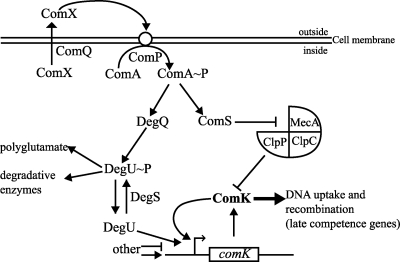FIG. 1.
Regulation of comK expression (only proteins and loci addressed in this work are mentioned). ComK activates the transcription of its own gene, forming a positive autoregulatory loop (30, 47). The DegS/DegU two-component system influences competence development in a way that dephosphorylated DegU facilitates the binding of ComK to its cognate promoter, thus leading to the onset of the autoregulatory loop; phosphorylated DegU promotes the synthesis of extracellular enzymes and polyglutamate (19) for biofilm formation. ComK levels are reduced posttranscriptionally at low cell density when MecA recruits ComK to the proteolytic MecA-ClpCP complex, making competence development quorum-sensing dependent (for details, see the text). Arrows and T bars indicate positive and negative regulation, respectively. ComX, peptide pheromone; ComQ, modification and secretion of ComX; ComP, sensor histidine kinase; ComA, response regulator; ComS, inhibition of MecA/ClpCP; DegQ, facilitator of the phosphorylation of DegU; DegU, response regulator; DegS, sensor histidine kinase; MecA, adaptor-protein; ClpCP, protease; ComK, main transcriptional activator of natural competence.

